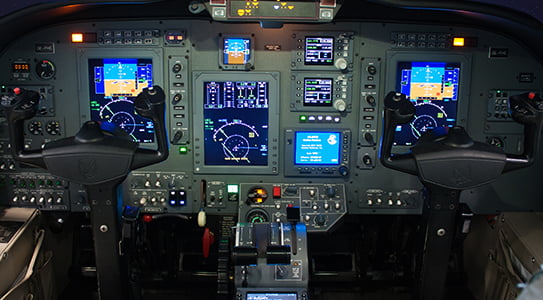With acronyms being used and NextGen Avionics in or coming into effect, avionics can be very confusing.
Here are a list of common avionics explained.
HUD – Heads Up Display
This takes the information from the Primary Flight Display (altitude, air speed, vertical speed, direction) and projects it onto a glass display that is in the pilot’s field of vision instead of down on the panel. Literally to keep the pilot’s head up to view this information while flying instead of looking down at the panel.
FDR – Flight Data Recorder
The “black box” (though technically orange) that records all the data of the flight you have just taken. It is required in many countries and is very expensive to install.
FMS – Flight Management System
Manages the details of your flight routing, fuel burn, speed, altitude, etc. Many regulations require at least one navigational computer. For oceanic crossings, your aircraft will need two FMS.
TCAS I v. TCAS II
TCAS I shows you where other aircraft are in the sky and how far away they are from you.
TCAS II does the same as TCAS I, but also tells you how to avoid other aircraft. TCAS II version 7.1 is a requirement in Europe for all aircraft over 12,500 pounds and will be required in the USA in 2020.
EVS – Enhanced Vision System
This takes infrared imaging of what is around you while you are flying so you can “see” even when visibility is low. Not a requirement but very nice to have.
ADS-B Out – Automatic Dependant Surveillance Broadcast Out
A communication system that broadcasts out where your aircraft is at all times. This is already a requirement in Asia, and will be required for EU aircraft in June 2020 and USA aircraft in January 2020.
Also see: Why Every Aircraft Owner Needs to Know about ADS-B Out
WAAS – Wide Area Augmentation System
WAAS is an upgrade to the current GPS systems that reduces the margin of error of spatial reporting, making your positioning readouts more accurate than previous systems.
LPV – Localizer Performance with Vertical Guidance
This uses GPS signals to guide the aircraft’s altitude and provides the ability to use GPS signals to fly the altitude component of the approach instead of having to rely upon ground based radios. LPV allows for more airports to have more precise instrument approaches without ground based systems.
CPDLC – Controller Pilot Data Link Communication
CPDLC allows for reduced radio communication between pilots and controllers by receiving airspace clearances and air traffic control altitudes and routing via text message. All aircraft currently in production that are going to be based or flown in Europe must have CPDLC.
Also see: What CPDLC means to Aircraft Owners
FANS 1-A – Future Air Navigation System
FANS 1-A is system that takes data from the aircraft instruments and transmits it via SATCOM to air traffic control. It provides for better reporting and therefore, better spacing and safety for aircraft crossing the North Atlantic Ocean. All aircraft flying over the North Atlantic Ocean between 35,000 and 39,000 feet must have FANS- 1- A installed. By January 2020, this will include the North Atlantic Ocean from 29,000 feet and above.
Also see: Why You Need to Care about FANS 1A




